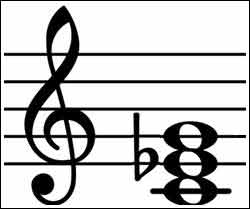
Mandolin Minor Chords
Minor chords can be built from the major scale using the 1st (root), the flatted 3rd (b3) and the 5th. That’s our formula for a minor triad: 1 – b3 – 5.
The minor triad is the same as the major triad only the 3rd is lowered by a semitone (half tone).
To get a minor, flat the 3rd. Its that easy!
As a result, any major chords that you might already have in your arsenal, can be made into a minor chord, simply by lowering the 3rd by a semitone (1 fret).
Major chords to a minor chords
Let’s start by taking a look at the A major scale again.

The 1st is A, the 3rd is C#, and the 5th is E: 1st, 3rd, 5th = A-C#-E
For a minor triad we have to flat the 3rd. The 3rd is a C#. If we flat that C# (lower it by one semitone), we get a C note. So, the 1st, flatted 3rd and 5th gives us: A-C-E
So our Am triad is A – C – E.
Below is the root position Amaj chord we built in the last section. The 3rd of that major chord is a C#, and it’s at the fourth fret of the second string. If we move it down to the third fret, then we’ve lowered that note by a semitone to a “C”. We end up with an “A minor” chord (Am). To make a major into a minor chord, you just flat the 3rd.
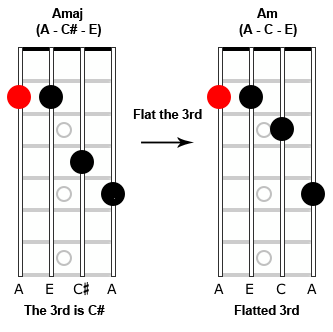
This is, of course, a moveable minor chord shape (see “Moveable Mandolin Chords“).
Try another
Here’s the D major scale:

The 1st is D, the 3rd is an F# and the 5th is A.
To build minor chords, we flat the third (1 – b3 – 5). Therefore, we flat the F# and end up with an ”F”.
Our Dm triad is D – F – A.
Below is a diagram of an open string Dmaj chord that I’m sure everyone is familiar with. The 3rd of a Dmaj triad is “F#”, and it’s at the second fret of the first string. If we flat that 3rd by moving it down one fret, we end up with an “F”, and we now have a Dm chord.
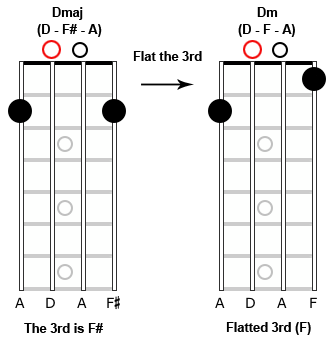
Minor construction
Of course, it’s also fun to just build the chord around a note. Let’s say we’ve done our “close your eyes and put your finger on the neck” exercise. When we open our eyes, our finger is on the third string (D string) at the eighth fret. That’s a Bb.
Let’s look at the Bb major scale:

Bb – C – D – Eb – F – G – A – Bb
The 1st (root) is “Bb”. The 3rd is D and the 5th is “F”. To build a minor chord we want to flat the third. Therefore, we end up with a ”Db”.
So our Bbm triad will be Bb – Db – F.
We know our root is on the eighth fret of the 3rd string (solid red), so let’s look at all the triad notes close to that.
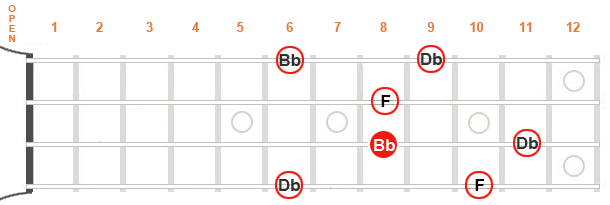
I’ll put my ring finger on our root note because I see a Db at the sixth fret of the 4th string (G string), and I’m going to cover that with my index finger. On the second string there’s an “F” at the eighth fret right beside our root note. I’ll put my pinky there.
Any options?
Now, if I want, I can mute the 1st set of strings with the fleshy part of my index finger and play the 3-note chord. However, on the first string I see another root note (Bb) at the sixth fret and a Db at the ninth. The easiest fingering for me from here would be to double up on the root note by fretting the first string at the sixth fret (with my middle finger).
We end up with the following Bbm chord (another moveable minor chord).
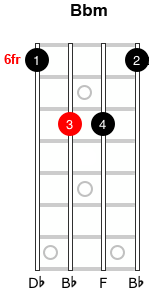
Just as a side note, did anyone recognize this as a 1st inversion Bbm chord? (Because the 3rd is the lowest note in the chord)
It’s always good to keep exploring when you can, because you might find something that works better. Here’s a few more Bb minor chords built off that same root note.
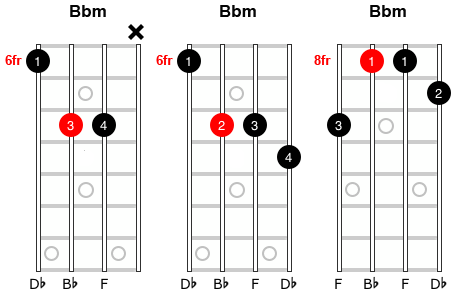
Try that exercise a few times. Put your finger on a fret, figure out what note it is, then build a minor chord around that root note. Take a little time to explore any other minor chords that might possible around the same root.
The intervals in a minor triad
In the section on major triads, we discussed two intervals – the Major 3rd and the minor 3rd.
If two notes are separated by 4 semitones, then they are a “Major 3rd” apart (M3). The interval of 4 semitones is called a “Major 3rd”.
If the distance between any two notes is 3 semitones (3 half tones), then they are separated by a “minor 3rd” (m3). The interval of 3 semitones is called a “minor 3rd”.
The distance between the 1st note (tonic) and the flatted 3rd note in the major scale is 3 semitones. That is a minor 3rd interval! The distance between that flatted 3rd note and the 5th note in the major scale is 4 semitones. That’s a major 3rd!
When we build a minor triad we use a minor 3rd, then a Major 3rd.

Look at the diagram of the C-major scale above. You can see that, once we flat the 3rd, we end up with a minor 3rd interval (3 semitones), then a Major 3rd (4 semitones).
So let’s compare intervals
The intervals used to build a major chord – Major 3rd – minor 3rd.
The intervals used to build a minor chord – minor 3rd – Major 3rd.
Its just the opposite for minor chords.
It is written
Minor chords are usually written with a small “m” after the chord letter, such as “Am”, or “Em”.
Next, we’ll have a look at augmented triads.
